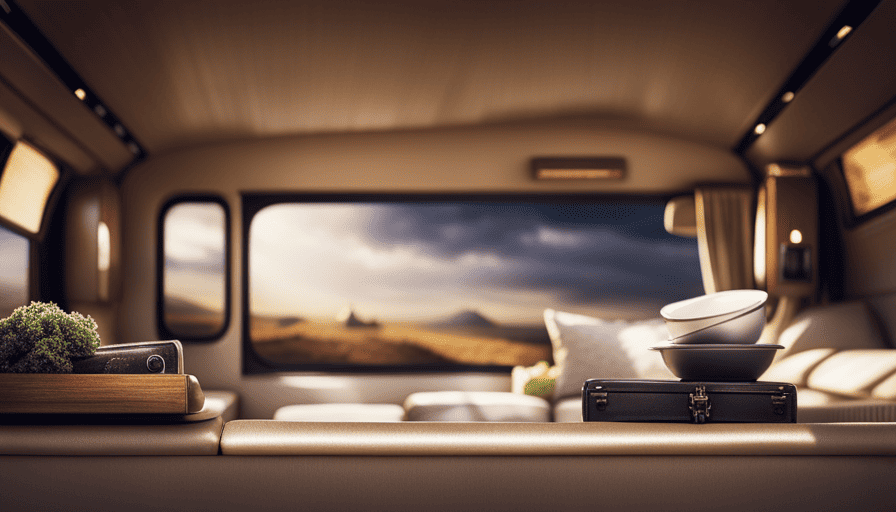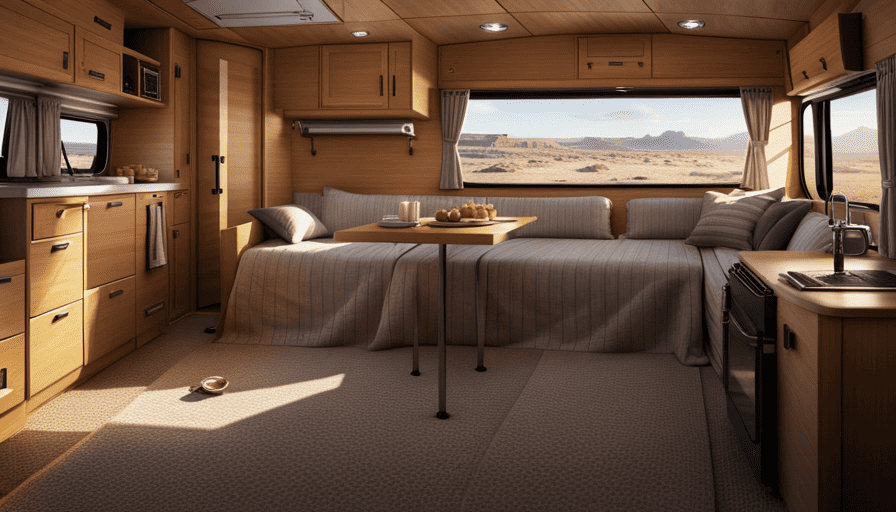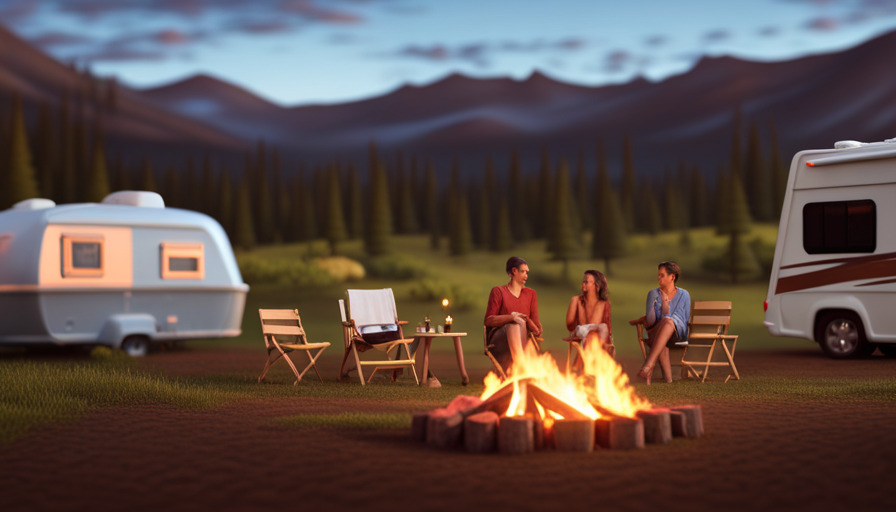Have you ever dreamed of hitting the open road, exploring new places, and embracing a nomadic lifestyle? I’m thrilled to share that this dream can become a reality with the right knowledge and a bit of creativity. Welcome to the world of van camping, where turning a simple van into a cozy, mobile home is completely achievable.
In this article, I will guide you through the process of interior van camper conversion, step by step. From assessing your needs and planning the layout to adding custom furniture and personalizing your space, we will cover it all. Get ready to transform a plain van into a functional and stylish camper that reflects your unique personality.
So, let’s dive in and discover the secrets of turning a van into your ultimate adventure companion.
Key Takeaways
- Assess needs and plan van conversion layout, considering space, storage options, and comfort.
- Insulate and soundproof the van for temperature control and noise reduction.
- Install flooring and wall paneling for a warm and inviting atmosphere, considering options like vinyl, laminate, hardwood, or bamboo flooring and materials like wood, PVC, aluminum, or fiberglass for wall paneling.
- Build custom furniture and storage solutions to maximize space, including customized seating areas with hidden storage, shelving units for organization, and install electrical and lighting systems for enhancing the van living experience.
Assess Your Needs and Plan the Layout
Now that you’ve decided to convert your van into a cozy camper, it’s time to assess your unique needs and plan out the perfect layout that suits your adventurous lifestyle.
Assessing the available space is key to maximizing comfort and functionality. Take measurements of your van’s interior and consider any specific requirements you may have. Do you need space for a kitchenette, a bed, or a bathroom? Visualize how you want your van to look and map out the different areas accordingly.
One important aspect to consider is optimizing storage. Think about the items you’ll need on your travels and how you can best organize them. Incorporate clever storage solutions like overhead compartments, under-bed drawers, or hanging shelves. Utilize vertical space by installing hooks and racks to hang clothing, kitchen utensils, or equipment.
Furthermore, make sure to leave enough open space for movement and relaxation. A clutter-free environment can greatly enhance your camping experience. Don’t forget to consider windows for natural light and ventilation, as well as insulation to regulate temperature.
Now that you’ve assessed your needs and planned the layout, it’s time to choose the right van that will accommodate your vision and provide the necessary space for your camper conversion.
Choose the Right Van
When selecting the ideal vehicle, it’s crucial to pick a van that perfectly suits your needs and preferences. A van conversion requires careful consideration of factors such as size, budget, and intended use.
Here are three important things to consider when choosing the right van for your van camping adventure:
-
Size: Determine how much space you need for your van conversion. Consider the number of people traveling with you, as well as the equipment and supplies you plan to bring along. A larger van will provide more room for comfortable living quarters, while a smaller van may be more maneuverable and fuel-efficient.
-
Budget: Set a budget for your van conversion project. Vans come in a wide range of prices, so it’s important to find one that fits within your financial means. Remember to consider not only the initial cost of the van but also any repairs or modifications that may be necessary.
-
Features: Consider the features you need in your van for a comfortable camping experience. Look for vans with amenities such as built-in beds, kitchenettes, or storage options. Think about whether you prefer a high roof or a low roof van, as this will affect the overall space and usability of your conversion.
Choosing the right van is just the first step in creating your dream van camper. Once you’ve found the perfect vehicle, the next important task is to insulate and soundproof your van.
Insulate and Soundproof Your Van
Once you’ve selected the right van for your van camping adventure, it’s time to ensure a cozy and quiet experience by insulating and soundproofing your vehicle.
Insulating your van has numerous benefits, such as maintaining a comfortable temperature inside, reducing condensation, and providing a barrier against outside noise. There are various insulation materials available, but one popular option is foam board insulation. It’s lightweight, easy to install, and provides excellent insulation properties. Another option is spray foam insulation, which fills all the nooks and crannies of your van, ensuring maximum insulation efficiency.
Soundproofing is equally important to create a peaceful environment inside your van. There are several soundproofing materials you can use, such as mass loaded vinyl, acoustic foam, and sound-deadening mats. Mass loaded vinyl is versatile and can be applied to walls, floors, and ceilings to block and absorb sound. Acoustic foam, on the other hand, helps to reduce echo and reverberation, creating a more pleasant acoustic environment. Sound-deadening mats can be used on the floor to dampen vibrations and reduce road noise.
With a well-insulated and soundproofed van, you can enjoy a peaceful and comfortable camping experience. Now that you’ve created a cozy and quiet space, it’s time to move on to the next step: installing flooring and wall paneling.
Install Flooring and Wall Paneling
To create a warm and inviting atmosphere, you’ll want to start by installing beautiful flooring and wall paneling in your cozy mobile haven.
When it comes to flooring options for your van camper, there are a few factors to consider. You’ll want something durable and easy to clean, since your floors will be subject to a lot of foot traffic. Vinyl flooring is a popular choice as it’s low-maintenance and comes in a wide range of styles and colors. Another option is laminate flooring, which is affordable and also offers a variety of designs. If you prefer a more natural look, hardwood or bamboo flooring can add a touch of elegance to your van.
Moving on to wall paneling materials, there are plenty of choices to suit your personal taste and style. Wood paneling gives a rustic and cozy feel, while PVC paneling is lightweight and easy to install. If you want something more modern, consider using aluminum or fiberglass paneling. These materials aren’t only aesthetically pleasing, but also provide insulation and soundproofing properties.
Now that you’ve chosen your flooring and wall paneling, it’s time to move on to the next step: building custom furniture and storage solutions to maximize the space in your van camper.
Build Custom Furniture and Storage Solutions
Get ready to create your own personal oasis on wheels by building custom furniture and storage solutions that will maximize every inch of space in your cozy mobile haven.
Here are some ideas to inspire you:
-
Custom Seating: Designing your own seating areas allows you to make the most of your van’s layout. Consider building a comfortable bench seat that doubles as storage, with cushions that can be easily removed for sleeping or lounging. You could also create a foldable table that can be tucked away when not in use, providing a versatile space for dining or working.
-
Hidden Storage: With limited space in a van, hidden storage is key. Build cabinets and drawers underneath your bed or seating areas to keep your belongings organized and out of sight. Don’t forget to utilize vertical space by adding shelves or hanging storage solutions on the walls.
-
Multi-functional Furniture: Make the most of your limited space by incorporating multi-functional furniture. Consider building a bed that can be transformed into a sofa during the day, or a table that can be used for both cooking and dining. This will allow you to maximize your living area without sacrificing functionality.
-
Customized Shelving: Install customized shelving units that fit the specific dimensions of your van. This will not only provide ample storage space for your belongings but also help keep everything organized and easily accessible.
Now that you’ve created custom furniture and storage solutions, it’s time to move on to the next step: installing electrical and lighting systems.
Install Electrical and Lighting Systems
Now that you’ve built your custom furniture and storage solutions, it’s time to bring your cozy mobile haven to life by installing electrical and lighting systems that will enhance your van living experience. Did you know that proper lighting can improve your mood and overall well-being while on the road?
To begin, I highly recommend installing solar panels on the roof of your van. Solar panels are a sustainable and efficient way to power your electrical systems. They harness the sun’s energy and convert it into electricity, allowing you to charge your devices and run appliances without relying solely on traditional power sources.
Next, you’ll need to wire your van to connect all your electrical components. This process involves carefully running wires through the van’s walls and ceiling, ensuring they are properly insulated and secured. It’s important to follow safety guidelines and consult with a professional if you’re unsure about any aspect of the wiring process.
To help you visualize the electrical setup, here’s a handy table outlining the components you’ll need:
| Component | Purpose | Recommended Brand |
|---|---|---|
| Solar Panels | Generate electricity from sunlight | Renogy |
| Batteries | Store excess energy for later use | Battle Born |
| Inverter | Converts DC power to AC power | Victron Energy |
| Fuse Box | Protects your electrical system | Blue Sea Systems |
| LED Lights | Energy-efficient lighting solution | MICTUNING |
Once your electrical system is in place, you’ll be ready to add a kitchen and bathroom setup to complete your van conversion. Transitioning seamlessly into the next section, you’ll be able to enjoy the comforts of home on the road.
Add a Kitchen and Bathroom Setup
Once you’ve electrified your cozy mobile haven, it’s time to spice things up by adding a kitchen and bathroom setup that will make your van feel like a home away from home.
In a limited space, maximizing kitchen storage is key. Consider installing cabinets, shelves, and drawers to keep your cooking essentials organized and within reach. Utilize vertical space by hanging pots and pans, and install a foldable table that can double as a prep area and dining space. Don’t forget to add a sink with a small countertop for easy meal preparation and clean-up.
When it comes to the bathroom, space is at a premium, so efficiency is crucial. Look for compact fixtures that can fit comfortably in your van. A toilet with a smaller footprint and a showerhead that can be attached to the wall are excellent options. Consider using a portable toilet for added convenience. To save space, install a shower curtain instead of a door.
Transitioning into the subsequent section about heating and cooling options, it’s important to consider the climate you’ll be traveling in. Depending on the weather, you may need to invest in heating or cooling systems to ensure your comfort throughout the journey.
Consider Heating and Cooling Options
To keep yourself comfortable on your travels, have you considered the heating and cooling options available for your cozy mobile haven? When converting a van into a camper, it’s important to ensure that you have the right temperature control systems in place.
Let’s explore some heating and cooling options that you can incorporate into your van camper.
For heating options, you may consider installing a propane heater or a diesel heater. Propane heaters are easy to use and provide consistent warmth, while diesel heaters are more fuel-efficient and can be integrated with your van’s fuel system. Another option is a wood-burning stove, which adds a rustic charm to your interior and can keep you cozy during colder nights. Keep in mind that safety should be a top priority when using any heating system, so make sure to install carbon monoxide detectors and proper ventilation.
When it comes to cooling options, you have a few choices. One option is installing a roof vent or fan, which can help circulate air and keep the temperature down on hot days. Another option is a portable air conditioner, which can be powered by your van’s electrical system or a separate power source. Additionally, reflective window coverings can help block out the sun’s heat and keep your camper cooler.
Considering the heating and cooling options available for your van camper is essential to ensure your comfort during your travels. Once you have your temperature control systems in place, you can move on to personalizing your camper with decor and accessories, making it a true reflection of your style and personality.
Personalize Your Camper with Decor and Accessories
Make your cozy mobile haven truly unique by personalizing it with your own style and personality through the addition of decor and accessories. One of the key aspects of van camper organization is creating a space that reflects your individual taste. By incorporating thoughtful decor and accessories, you can transform your van into a home away from home.
To inspire your creativity, here are some van camper bed ideas and decor suggestions that will make your interior both functional and inviting:
| Bed Ideas | Decor and Accessories |
|---|---|
| Foldable Murphy bed | String lights |
| Loft bed | Cozy throw pillows |
| Convertible sofa | Wall art |
| Bunk beds | Hanging plants |
| Hammock | Curtains or blinds |
| Trundle bed | Area rug |
These ideas provide a starting point for designing a comfortable sleeping area, while the decor and accessories add personality and warmth to the space. Consider using soft lighting, such as string lights, to create a cozy ambiance. Add throw pillows and blankets to make the bed inviting and comfortable. Hang artwork that reflects your personal style, and incorporate plants to bring a touch of nature indoors. Curtains or blinds can provide privacy and also add a decorative element. Finally, an area rug can tie the whole space together and make it feel like home.
With these van camper organization ideas and decor suggestions, you can create a personalized and inviting interior. Next, we’ll explore how to test and fine-tune your interior van camper to ensure it meets your needs perfectly.
Test and Fine-Tune Your Interior Van Camper
Are you ready to put the finishing touches on your cozy mobile haven and make sure it’s perfect for your adventures? As you test and fine-tune your interior van camper, there are a few key things to keep in mind.
Choosing the right materials is crucial in creating a durable and comfortable space. Opt for materials that are lightweight, easy to clean, and resistant to wear and tear. Consider using laminate flooring for easy maintenance and durability, and go for moisture-resistant fabrics for your upholstery to withstand any spills or accidents.
Maximizing space utilization is another important aspect to consider. Think creatively about how to make the most of every inch of your van. Install shelves or cabinets along the walls to provide extra storage space, and consider using multi-functional furniture pieces such as a sofa that can also be converted into a bed. Hang hooks or install a magnetic strip to keep your kitchen utensils organized and easily accessible.
To create a cozy and inviting atmosphere, add some personal touches. Hang curtains or blinds to add privacy and control the amount of natural light coming in. Decorate with throw pillows, blankets, and rugs to make your van feel like a home away from home.
Finally, don’t forget to test everything out by taking a short trip to ensure that everything is in working order and to make any necessary adjustments. With these tips in mind, your interior van camper will be ready for your next adventure!
Frequently Asked Questions
What are some common safety precautions to consider when building an interior van camper?
When building an interior van camper, it’s crucial to prioritize safety. One important safety precaution is to ensure that you have proper safety equipment on board. This includes fire extinguishers, carbon monoxide detectors, and first aid kits.
Additionally, when it comes to electrical wiring, it’s essential to use the correct gauge wire and install it properly to prevent any potential fire hazards. By taking these precautions, you can enjoy your van camper adventures with peace of mind.
How can I maximize storage space in a small van camper?
To maximize storage space in a small van camper, I employ some clever techniques.
Firstly, I utilize under-bed storage for bulky items like bedding and clothing.
Additionally, I make use of overhead compartments and hanging organizers for smaller items.
In the kitchen area, I install foldable shelves and magnetic spice racks to optimize space.
By strategically organizing and utilizing every nook and cranny, I create a functional and efficient living space while still maximizing sleeping space and organizing the kitchen area.
What are some budget-friendly options for insulating and soundproofing a van camper?
Did you know that a well-insulated and soundproofed van camper can make your road trips more comfortable and enjoyable?
When it comes to insulating materials, consider using budget-friendly options like reflective insulation or foam board.
For soundproofing, you can use mass-loaded vinyl or acoustic foam panels.
These techniques will help to keep your van camper warm during colder months and reduce external noise.
Now, let’s dive into how to interior your van camper to create a cozy and practical space.
Are there any specific building codes or regulations I need to follow when converting a van into a camper?
When converting a van into a camper, it’s important to consider building codes and regulations to ensure safety. Some key safety precautions include properly securing furniture and appliances, installing smoke and carbon monoxide detectors, and following electrical wiring guidelines.
Additionally, maximizing storage space is crucial, so consider using budget-friendly options for insulating and soundproofing. Don’t forget to carefully calculate water tank size and capacity based on your needs for a comfortable camping experience.
How do I choose the right size and capacity for a water tank in my van camper?
When choosing the right size and capacity for a water tank in my van camper, I consider several factors.
Firstly, I evaluate my water needs based on the number of people traveling with me and the duration of our trips.
Then, I research different water tank options, considering their dimensions and capacity.
Additionally, I prioritize choosing materials that’re durable and lightweight.
Lastly, I explore water filtration options to ensure a clean and safe water supply during my adventures.
Conclusion
In conclusion, transforming a van into a camper is a labor of love that requires careful planning and execution.
By assessing your needs and designing a layout that maximizes space, choosing the right van, insulating and soundproofing, and installing the necessary features, you can create a cozy and functional home on wheels.
Adding personal touches and accessories will truly make it your own. Remember, Rome wasn’t built in a day, so take your time and fine-tune your interior van camper to perfection.
As the saying goes, "The devil is in the details," so pay attention to every little aspect to achieve the ultimate van life experience.











